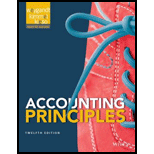
(a)
(1)
Periodic Inventory System: It is a system in which the inventory is updated in the accounting records on a periodic basis such as at the end of each month, quarter or year. In other words, it is an accounting method which is used to determine the amount of inventory at the end of each accounting period.
Inventory cost flow: It refers to the flow (movement) of inventory when it is purchased or sell by the business organization.
The various inventory cost flow methods are:
- First-in, first-out (FIFO)
- Last in, first-out (LIFO)
- Average-cost
FIFO method: In FIFO method, those goods are sold first which are purchased first by the business organization.
LIFO method: In LIFO method, those goods are sold first which are purchased in last by the business organization
To determine: The cost of ending inventory and cost of goods sold under the FIFO method
(2)
The cost of ending inventory and cost of goods sold under LIFO method and LIFO method.
(b)
The costing method which will report higher ending inventory and its reason.
(c)
The costing method which will report higher cost of goods sold and its reason
Want to see the full answer?
Check out a sample textbook solution
Chapter 6 Solutions
Accounting Principles - Standalone book
- Please provide the correct answer to this general accounting problem using accurate calculations.arrow_forwardCan you help me solve this general accounting question using valid accounting techniques?arrow_forwardPlease provide the solution to this general accounting question using proper accounting principles.arrow_forward

 AccountingAccountingISBN:9781337272094Author:WARREN, Carl S., Reeve, James M., Duchac, Jonathan E.Publisher:Cengage Learning,
AccountingAccountingISBN:9781337272094Author:WARREN, Carl S., Reeve, James M., Duchac, Jonathan E.Publisher:Cengage Learning, Accounting Information SystemsAccountingISBN:9781337619202Author:Hall, James A.Publisher:Cengage Learning,
Accounting Information SystemsAccountingISBN:9781337619202Author:Hall, James A.Publisher:Cengage Learning, Horngren's Cost Accounting: A Managerial Emphasis...AccountingISBN:9780134475585Author:Srikant M. Datar, Madhav V. RajanPublisher:PEARSON
Horngren's Cost Accounting: A Managerial Emphasis...AccountingISBN:9780134475585Author:Srikant M. Datar, Madhav V. RajanPublisher:PEARSON Intermediate AccountingAccountingISBN:9781259722660Author:J. David Spiceland, Mark W. Nelson, Wayne M ThomasPublisher:McGraw-Hill Education
Intermediate AccountingAccountingISBN:9781259722660Author:J. David Spiceland, Mark W. Nelson, Wayne M ThomasPublisher:McGraw-Hill Education Financial and Managerial AccountingAccountingISBN:9781259726705Author:John J Wild, Ken W. Shaw, Barbara Chiappetta Fundamental Accounting PrinciplesPublisher:McGraw-Hill Education
Financial and Managerial AccountingAccountingISBN:9781259726705Author:John J Wild, Ken W. Shaw, Barbara Chiappetta Fundamental Accounting PrinciplesPublisher:McGraw-Hill Education





